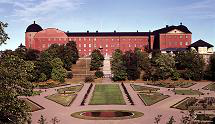Speaker
Dr
Dirk van der Werf
(Swansea University)
Description
At temperatures and densities relevant to current experiments antihydrogen is mainly formed through the three-body process pbar + e+ + e+ -> Hbar + e+. The state formed initially through this process is a Rydberg state, usually with a binding energy of only a few Kelvin. This state is fragile, and will not survive interaction with external fields or other particles, unless it is first stabilized through further collisions with positrons. Much more often, though, collisions with positrons will destroy the weakly bound antiatom, and only a very small fraction of the initially formed atoms will gain sufficient binding energy to reach a stable state. Simulations have shown that antiatoms are stable against collisional ionization once they have reached a binding energy greater than about 10 times the temperature of the positron plasma – the so called “bottleneck” [1].
In all experiments, the antihydrogen is formed in a static magnetic field with a strength ~1 Tesla. At positron-antiproton separations of a few microns, typical for the Rydberg antihydrogen in their initial states, magnetic forces will dominate. Thus the cyclotron energy of the positron is a conserved quantity, and the antiatom may remain bound even if its total energy (including the cyclotron energy of the positron) lies above the ionization threshold. On rare occasions, the positron passes close to the antiproton, which causes its cyclotron energy to rapidly change. The bound states with positive total energies are therefore metastable, as was pointed out by [2]. Through the inverse process, a metastable state can be formed in a positron-antiproton collision where the positron passes very close to the antiproton.
We have simulated antihydrogen formation through classical particle-in-a-box calculations, in order to investigate the importance of formation and decay of these metastable states. We compare to similar calculations using the Guiding Center Approximation (GCA), where the cyclotron energy of the positrons is not allowed to change. We find that, though the formation of the initial antihydrogen state is usually well described by the GCA, the energy transfer is typically much larger in collisions where a metastable state is formed. These states are therefore more likely to survive further collisions. We find that inclusion of this mechanism has a significant impact on the formation rate of antihydrogen with binding energy of the order of the bottleneck energy.
References
[1] E. M. Bass and D. H. E. Dubin, Phys. Plasmas 16 (2009) 012101; M. E. Glinsky and T. M. O’Neil, Phys. Fluids B 3 (1991) 1279
[2] C. E. Correa, J. R. Correa and C. A. Ordonez, Physical Review E 72 (2005) 04640
Primary author
Dr
Svante Jonsell
(Stockholm University)
Co-authors
Dr
Dirk van der Werf
(Swansea University)
Prof.
Michael Charlton
(Swansea University)

